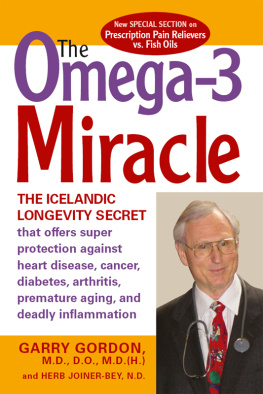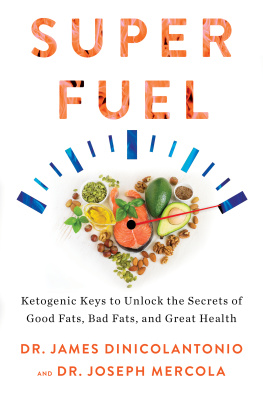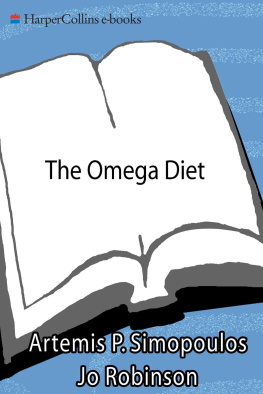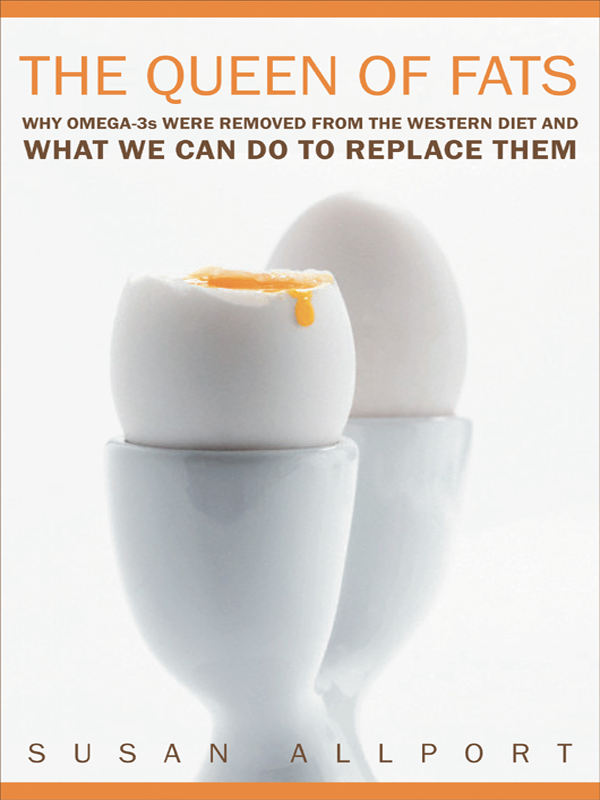THE QUEEN OF FATS
WHY OMEGA-3s WERE REMOVED FROM THE
WESTERN DIET AND WHAT WE CAN DO TO
REPLACE THEM
SUSAN ALLPORT

University of California Press, one of the most distinguished university presses in the United States, enriches lives around the world by advancing scholarship in the humanities, social sciences, and natural sciences. Its activities are supported by the UC Press Foundation and by philanthropic contributions from individuals and institutions. For more information, visit www.ucpress.edu.
University of California Press
Berkeley and Los Angeles, California
University of California Press, Ltd.
London, England
2006 by Susan Allport
Library of Congress Cataloging-in-Publication Data
Allport, Susan.
The queen of fats : why omega-3s were removed from the Western diet and what we can do to replace them / Susan Allport.
p. cm.
(California studies in food and culture; 15)
Includes bibliographical references and index.
ISBN-13, 978-0-520-24282-1 (alk. paper),
ISBN-10, 0-520-24282-3 (alk. paper)
1. Essential fatty acids in human nutrition. 2. Omega-3 fatty acidsHealth aspects. 3. Omega-3 fatty acids ResearchHistory. I. Title. II. Series.
QP752.O44A45 2006
612 .3'97dc22 2005035605
Manufactured in the United States of America
15 14 13 12 11 10 09 08 07 06
10 9 8 7 6 5 4 3 2 1
This book is printed on New Leaf EcoBook 60, containing 60% post-consumer waste, processed chlorine free; 30% de-inked recycled fiber, elemental chlorine free; and 10% FSC-certified virgin fiber, totally chlorine free. EcoBook 60 is acid-free and meets the minimum requirements of ANSI/ASTM d5634 01 (Permanence of Paper).
FOR THE SCIENTISTS WHO PIECED TOGETHER THIS STORY AND FOR MY FAMILY, THE MOST NOURISHING A WRITER COULD HAVE
CONTENTS
ONE
WHATS FOR DINNER?
I look upon it, that he who does not mind
his belly will hardly mind anything else.
SAMUEL JOHNSON, 1763
THE YEAR 2003 WILL BE REMEMBERED AS A TIME WHEN AMERICA LOST its dietary senses. Overnight, it seemed, this country switched from a low-fat regime, in which people shunned every form of visible fat, to the Atkins regime, in which fat consumption was encouraged but carbohydrates were to be avoided. Jack Sprat, who could eat no fat, suddenly became Sprats wife and could eat no lean.
The accumulated nutritional advice from decades of research was tossed aside like an old blanket, and grocery stores were suddenly filled with such gastronomical oxymora as low-carb bread and beer. Thin women in tight jeans were overheard saying that they loved beets and apples but had to stay away from them because of all their carbs. Large men in business suits ordered bunless burgers dripping with bacon grease and raved about their diets. Anyone coming back to the United States after time spent in Europe or Asia had an Alice-in-Wonderland experience, as several returnees told me: black had become white and carbohydrates, the food that feeds most of the worlds peoples, including the worlds leanest peoples, were suddenly the bad guys.
But 2003 should be remembered not only as the year that America lost its dietary senses (which it did) but also as the year that the center would no longer hold. By 2003, the nutritional advice given out to Americans by government agencies like the United States Department of Agriculture and medical organizations like the American Heart Association had become so out of sync with current research and biological understanding that schisms and confusion became inevitable.
It is unfortunate that those schisms took the form of total rejection, on the part of many Americans, of all the acquired wisdom about what constitutes a healthy diet. But thats what happens when the center doesnt hold, when the marketplace is full of such absurdities as overly sweetened breakfast cereals, such as Cocoa Puffs and Lucky Charms, being endorsed by the American Heart Association (because they have no cholesterol or saturated fat)when the oversimplistic, low-fat mantra of the 1980s and 1990s made the Atkins craze almost inescapable. As a dieter in Texas confides, Eating low-fat guarantees that I will binge on fried foods. Eating low-carb guarantees that I will binge on a bag of chips.
Much of the country is now on that fried-food, high-fat binge (or has binged out on Atkins and moved on). Many of us are more confused than ever about the simplest, most fundamental of questions: What should we have for dinner?
In the midst of this confusion, Id like to throw my hat into the ring of nutritional advice with a tribute to one food, or family of foods: the fatty acids popularly known as the omega-3s. Because these fats were not recognized as being essential to human health until the 1980s, most current recommendations and nutritional advice took shape without them. At the same time, they were being eliminated from many foods because their presence caused problems with product stability and shelf life. Their absence, from our foods and our guidelines, is a key, a large and growing number of scientists believe, to many of our health problems and even our befuddlement about food.
I have none of the usual qualifications to write this homage. I am neither a physician who treats the diseases to which people who are deficient in these fats are prone nor a scientist who has spent a lifetime researching the membranes that these fats call home. But that may be an advantage, since scientists and physicians tend to focus on the one piece of the puzzle they are looking at and these fats, as it turns out, affect the entire body in many different ways.
Rather, I am a science writer, a curious denizen of twenty-first-century America with a long-standing interest in food and the difficulties of being a human omnivore, and I will try to present the big picture. Quite simply, trying to understand health and diet without an appreciation of these fats is like trying to understand earthquakes without knowledge of plate tectonics, or motion without knowledge of physics. Until we revise our foods and guidelines to incorporate all that has been learned about omega-3 fatty acids in the past fifty years, our diet will be lacking in a very important way.
After I introduce these fats, I think you will begin to see why they deserve this book of their own. This introduction will involve some chemistry, but only what is necessary and most of which will be familiar to cooks, shoppers, and nutrition-conscious readers. Further explanations and diagrams can be found in the glossary, which begins on page 159. All that readers need to know from the get-go is that fatty acids, the components of fats and cell membranes, are chains of carbons and hydrogens with an acidic group at one end. The first of the omega-3 fatty acids is alpha linolenic acid, or ALA, the single parent of this family of fats. Found primarily in the leaves and other green parts of plants, alpha linolenic acid is the fat associated with the complex photosynthetic machinery of plants, the fat that enables plants to capture single photons of light and turn them into sugars, the basis of all life on earth. Alpha linolenic acid doesnt play a significant role in animals, for reasons I will soon discuss, but it does give rise to offspring who do work that is every bit as important to animals as photosynthesis is to plants.







